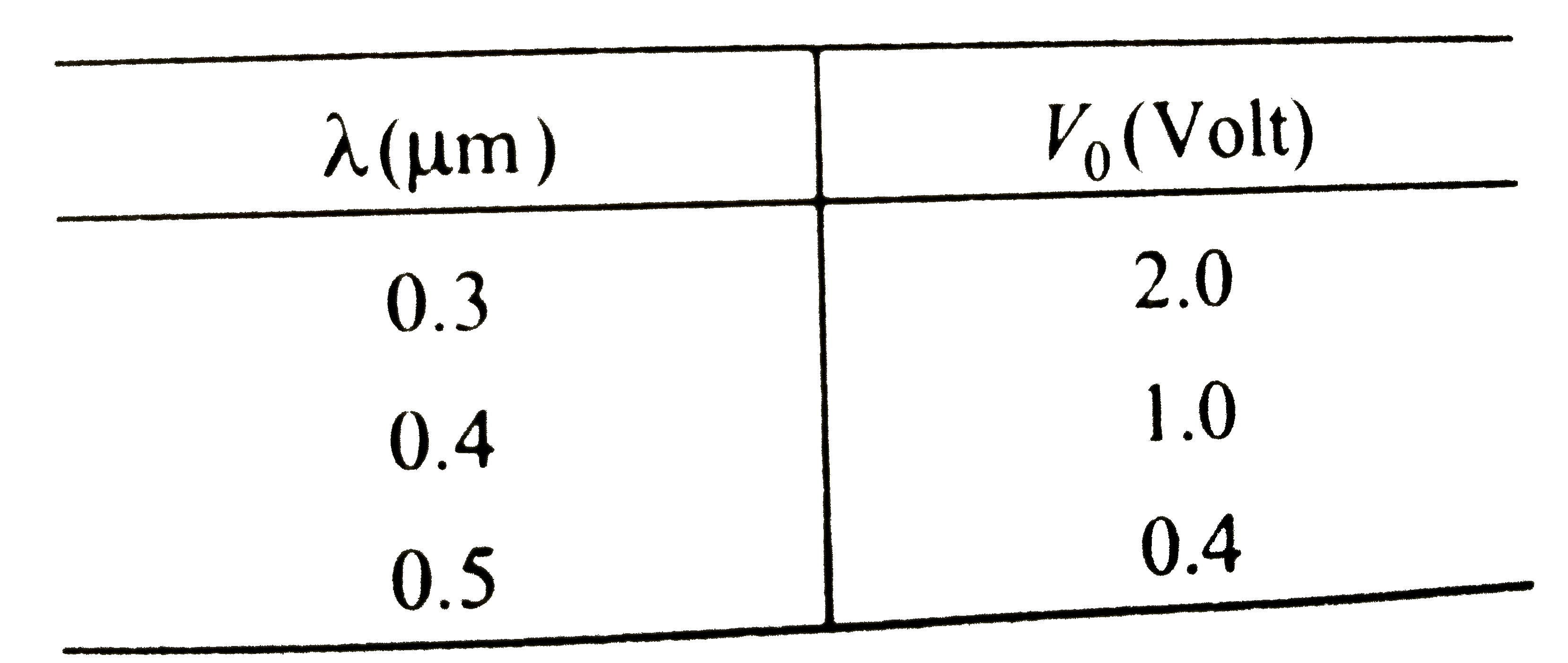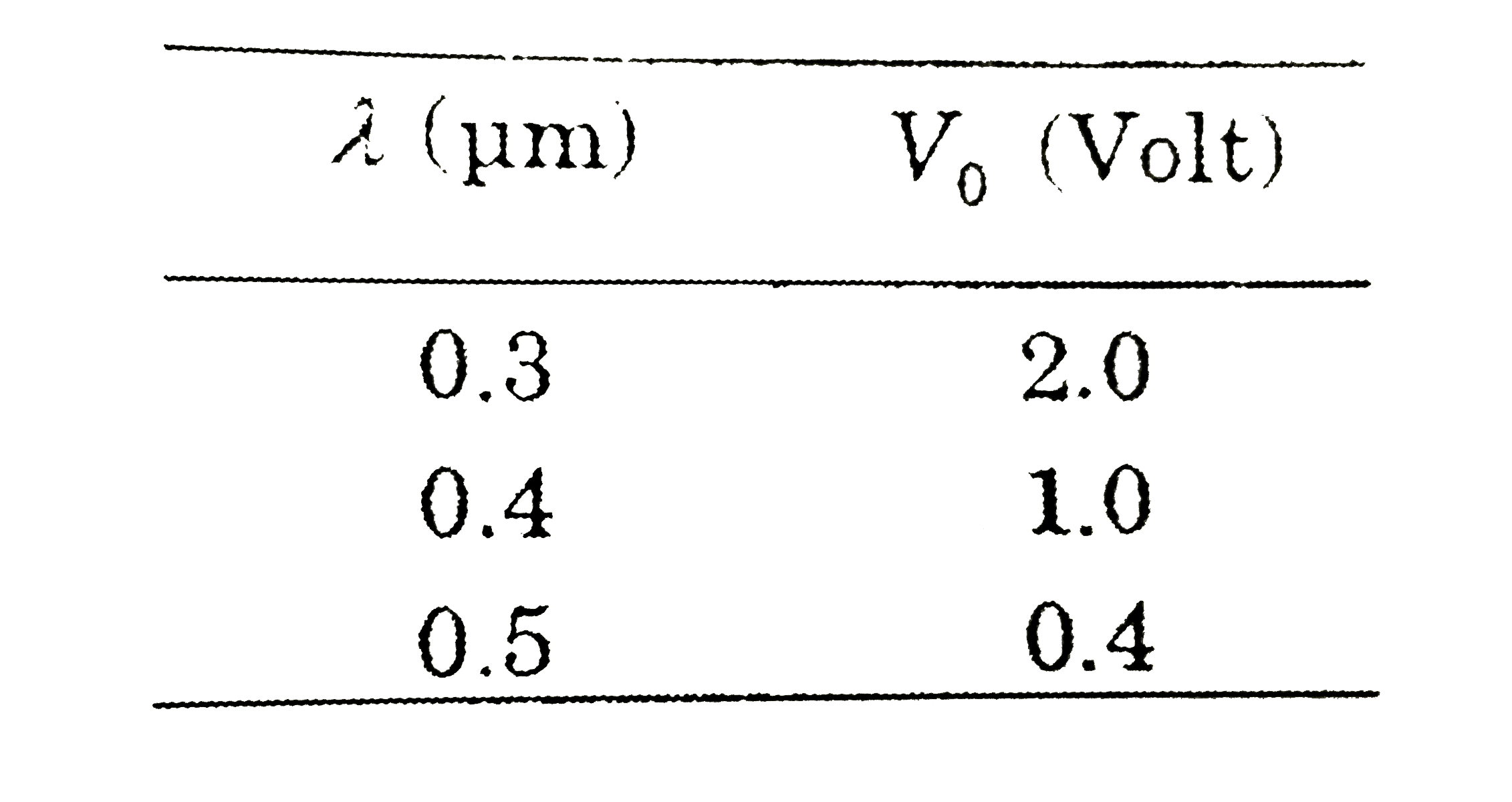In a historical experiment to dtermine Planck's constant, a metal surface was irradiated with light of different wavelengths. The emitted photoelectron energies were measured by applying a stopping potential. The relevant data for wavelength (λ) of incident light and the corresponding stopping potential (V0) are given below

Given that c=3×108ms−1 and e=1.6×10−19C, Planck's constant (in units of J s) found from such an experiment is:
6.0×10−34
6.4×10−34
6.6×10−34
6.8×10−34.
The correct Answer is:B
For photoelectronic emission,
hcλ=E0+eV0 . . . .(i)
Here, kinetic energy of photoelectron (12mv2)=eV0
h×3×1080.4×10−6=E0+1.6×10−19×2 . . . .(ii)
h×3×1080.4×10−6=E0+1.6×10−19×1 . . . .(iii)
Substracting eq. (iii) from eq. (ii) we get
h[1015−0.75×1015]=1.6×10−19 ltBrgt h×0.25×1015=1.6×10−19
h=6.4×10−34Js
Topper's Solved these Questions
- ATOMIC STRUCTURE BOOK - OP TANDONCHAPTER - ATOMIC STRUCTURE EXERCISE - Assertion Reason
22 Videos
- ATOMIC STRUCTURE BOOK - OP TANDONCHAPTER - ATOMIC STRUCTURE EXERCISE - Matrix matching Type Question
5 Videos
- ATOMIC STRUCTURE BOOK - OP TANDONCHAPTER - ATOMIC STRUCTURE EXERCISE - Set-2
46 Videos
- AROMATIC HYDROCARBONS (ARENES)BOOK - OP TANDONCHAPTER - AROMATIC HYDROCARBONS (ARENES)EXERCISE - EXAMPLES
24 Videos
- CHARACTERISATION OF ORGANIC COMPOUNDS BOOK - OP TANDONCHAPTER - CHARACTERISATION OF ORGANIC COMPOUNDS EXERCISE - Passage-2
5 Videos
Similar Questions
In a historical experiment to determine Planck's constant, a metal surface was irradiated with light of different wavelengths. The emitted photoelectron energies were measured by applying a stopping potential. The relevant data for the wavelength (λ). ) of incident light and the corresponding stopping potential (V0) are given below :

Given that c=3×108ms−1ande=1.6×10−19C Planck's constant (in units of J s) found from such an experiment is
View SolutionIn a historical experiment to determine Planck's constant, a metal surface was irradiated with light of different wavelengths. The emitted photoelectron energies were measured by applying a stopping potential. The relevant data for the wavelength (λ). ) of incident light and the corresponding stopping potential (V0) are given below :

Given that c=3×108ms−1ande=1.6×10−19C Planck's constant (in units of J s) found from such an experiment is
View Solution
Knowledge Check
When light of wavelength 400nm is incident on the cathode of photocell, the stopping potential recorded is 6V. If the wavelength of the incident light is to 600nm, calculate the new stopping potential. [Given h=6.6×10−34Js,c=3×108m/s,e=1.6×10−19C]
A1.03VB2.42VC4.97VD3.58VWhen a certain metallic surface is irradiated with monochromatic light wavelength λ, the stopping potential for photoelectric current is 3V0. When the same surface is irradiated with light of wavelength 2λ, the stopping potential is V0 The threshold wavelength for the given surface is
A4λB6λC8λD4λ3Light of wavelength 3×10−7m is incident on a photosensitive surface . The stopping potential for emitted photoelectrons is 2.5 V . If the wavelength of incident light is reduced to 1.5×10−7 m , the stopping potential for emitted photoelectrons is
Aequal to 5 VBless than 5 VCmore than 5 VDbetween 2.5 V and 5 V
When light of wavelength 400nm is incident on the cathode of photocell, the stopping potential recorded is 6V. If the wavelength of the incident light is to 600nm, calculate the new stopping potential. [Given h=6.6×10−34Js,c=3×108m/s,e=1.6×10−19C]
View SolutionPhotoelectrons ar ejected from a surface when light of wavelenght λ1=550nm is incident on it. The stopping potential for such electrons is λS1=0.19V. Suppose that radiation of wavelength λ2=190nm is incident of the surface.
Q. Calculate the stopping potential VS2.
View SolutionIn an experiment on photoelectric emission from a metallic surface ,wavelength of incident light 2×10−7 m and stopping potential is 2.5V .The threshold frequency of the metal (in Hz) approximately
(Charge of electrons e=1.6×10−19C, Planck's constant ,h=6.6×10−34J−s)
View SolutionPhotoelectrons ar ejected from a surface when light of wavelenght λ1=550nm is incident on it. The stopping potential for such electrons is λS1=0.19V. Suppose that radiation of wavelength λ2=190nm is incident of the surface.
Q. Calculate the stopping potential VS2.
View SolutionIn an experiment on photo- electric effect, stopping potential is 1.0 V when light of wavelenght 6520 Å is incident on the emitting surface. The stopping potential is 2.9 V for light of wavelenght 3260 Å. The function of the metal is
View Solution
